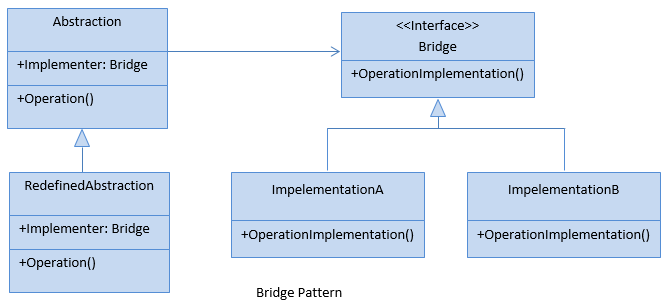Structural Design Pattern: Bridge Design Pattern
Duration : 00:02:00
Define Bridge Design Pattern
The bridge design is used to separate concepts and implementation so that they can be adjusted independently. This pattern includes an interface that serves as a bridge between the abstraction and implementer classes, as well as making the implementer's functionality independent of the abstraction.
Bridge Design pattern with UML diagram

The classes, interfaces, & objects in the above UML class diagram are listed as follows:
- Abstraction: This is an abstract class with members that define an abstract business item and its capabilities. It references a Bridge-type object. It can also serve as a foundational class for other abstractions.
- Redefined Abstraction: This class is derived from the Abstraction class. It extends the interface defined by the Abstraction class.
- Bridge: This interface serves as a link between the abstraction and implementer classes, allowing the implementer class's functionality to be independent of the abstraction class.
- ImplementationA and ImplementationB: These classes implement the Bridge interface and give implementation details for the corresponding Abstraction class.
When to use a Bridge Design pattern?
- The bridge design pattern is useful for independently modifying abstractions and implementations.
- Changes in the implementation of an abstraction should not affect clients.
- The Bridge pattern is used when a new version of a software or system is released while the older version of the software continues to run for its existing clients. There is no need to alter the client code; nevertheless, the client must pick which version to use.
Advantages of the Bridge Design Pattern:
- Decoupling: It separates an abstraction from its implementation, allowing it to change independently.
- Single Responsibility concept: It advances the idea by separating an abstraction from its application.
- Flexibility: Increases framework and implementation flexibility.
- Extensibility: Abstractions and implementations can be extended separately.
- Prevents Cartelization: Prevents Cartelization prevents the 'cartesian product' complexity explosion. For example, if you have N abstractions and M implementations, you do not require N*M classes.
Still have some questions? Let's discuss.
CONTACT US

